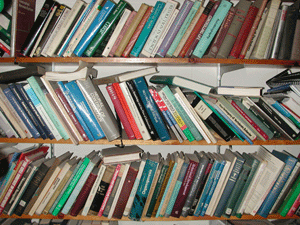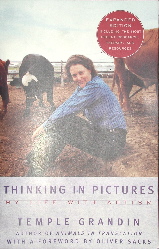Serendip is an independent site partnering with faculty at multiple colleges and universities around the world. Happy exploring!
Thinking in Pictures: My Life with Autism

|
Serendip's Bookshelves |
 Temple Grandin, Thinking in Pictures: My Life with Autism. Vintage, 2005 Temple Grandin, Thinking in Pictures: My Life with Autism. Vintage, 2005
Commentary by Paul Grobstein (August 2006). |
| "The more I learn, the more I realize more and more that how I think and feel is different." |
For me, though, what is particularly intriguing about Grandin's book is its contributions to thinking about the meanings of "emotion" and "empathy" and, in turn about the nature of social interaction and cultural organization. That people "on the spectrum" interact differently than others is clear and striking, enough so so that some people think of autism as primarily and perhaps even specifically a "deficit" in social interactions. There is an intriguing parallel to Alzheimer's here. That people with Alzheimer's no longer "recognize" their friends and family is what is most striking to many people but is actually a distinctly secondary consequence of changes in brain organization that are evident in a variety of other and more basic behavioral functions. My guess, based in large part on Grandin's book, is that the same holds for people "on the spectrum". That they interact differently is noticed by others not because that is the only way they are different but rather because that's the kind of difference that others most readily respond to and that most immediately disturbs them. Differences that may in fact be more basic are less readily noticed.
Grandin readily acknowledges that "Social interactions that come naturally to most people can be daunting for people with autism" (Chapter 7) and wrestles (cf Chapter 4) with the origins and significance of that difference. What seems quite clear (to me at least) from the "inside" evidence Grandin provides is that those "on the spectrum" are not appropriately characterized either as un-emotional or un-empathic. They are fully capable both of strong emotions and of quite significant connection to aspects of the "inside" of others. What is difficult for those on the spectrum in the social context is not either emotion or empathy per se but more specifically the "complex emotion in a human relationship" and "complex social interactions" in general. People "on the spectrum" seem to be less in touch than many other people not with emotion itself nor with other humans beings but rather with a complex set of intertwined emotions and social conventions that derive from, and attribute particularly high significance to, human social interactions and identities. In the social arena, and perhaps elsewhere, it seems to be not the simple things that create troubles. What creates problems for those "on the spectrum" is recognizing and sharing the coherent sense others make, without thinking about it, out of the most complex ones.
Is it useful to think of those "on the spectrum" as having a "deficit? in this regard or any other? Grandin clearly acknowledges with some regret that there are things she can't do that other people can ("I know I am missing something when other people swoon over a beautiful sunset") but expresses equally great pleasure and (entirely appropriate) pride in things she can do that other people can't, things that she clearly and compellingly attributes to "on the spectrum" characteristics. Who among us wouldn't be content with a life that generates that sort of mix of regret with pleasure and pride?
And what about in the social realm? Clearly, people "on the spectrum" experience difficulties dealing with those who aren't. This, though, is a culture-specific "disability" rather than a generic one. It can be dealt with by people not "on the spectrum" altering their expectations of social interactions with people who are and, as Grandin urges, by making special efforts to teach people "on the spectrum" social "skills". What about, in addition, taking seriously the notion that people "on the spectrum" are not generically "disabled" but rather simply different? And hence that those not "on the spectrum" might have something useful to learn from those we are? Given the kinds of troubles we frequently find ourselves in as individuals, groups, and nations, I suspect that a little less preoccupation with "a complex set of intertwined emotions and social conventions that derive from, and attribute particularly high significance to, human social interactions and identities" might be good for all of us. Perhaps those "off the spectrum" could usefully learn from those on it to stop perpetuating "the performance of dysfunctional, destructive, and impossible rituals as a way of maintaining group identity"?
Grandin is not so ambitious as to suggest that our feelings about autism might be taken as the starting point of a critique of some fairly deep cultural presumptions and, by extension, some fairly deep individual presumptions in most of us. That suggestion, though, seems to me to follow directly from the story she tells. The story invites us all to think about ways we might change our culture to get it "less wrong", not only in regard to autism but more generally. Perhaps we need to recognize that culture itself is too often a way to make us all feel more similar, and hence accepted by, other people? And realize that what we actually need is a better understanding that individual and social well being may "depend as much on the differences among individuals as it does on their similarities"? For each of us to be able to say, with confidence and pride "The more I learn, the more I realize more and more that how I think and feel is different" would be a wonderful step in that direction.



Comments
iPicto
Hi,
I would like to draw attention to our new app, called iPicto, for iPhone, iPod Touch
and iPad.
This app is designed to guide people with a (mental) disability, with or without
dementia/alzheimer, asperger, autism and / or a disorder in communication.
This new app iPicto is also a very good tool in learning a way of communication,
for example speech difficulties.
I refer you for further information, visit the App Store.
See for it:
and
Thank you for attention,
Sincerely,
Erwin van den Hout
The Netherlands